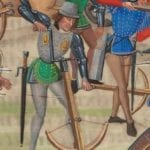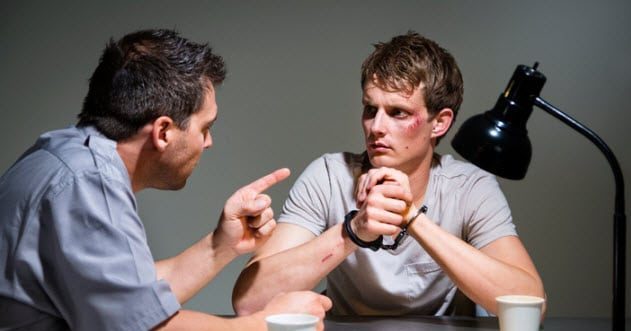 Our World
Our World  Our World
Our World  Movies and TV
Movies and TV The 10 Coolest Stars to Set Sail on The Love Boat
 History
History 10 Things You Didn’t Know About the American National Anthem
 Technology
Technology Top 10 Everyday Tech Buzzwords That Hide a Darker Past
 Humans
Humans 10 Everyday Human Behaviors That Are Actually Survival Instincts
 Animals
Animals 10 Animals That Humiliated and Harmed Historical Leaders
 History
History 10 Most Influential Protests in Modern History
 Creepy
Creepy 10 More Representations of Death from Myth, Legend, and Folktale
 Technology
Technology 10 Scientific Breakthroughs of 2025 That’ll Change Everything
 Our World
Our World 10 Ways Icelandic Culture Makes Other Countries Look Boring
 Our World
Our World 10 Ways Your Christmas Tree Is More Lit Than You Think
 Movies and TV
Movies and TV The 10 Coolest Stars to Set Sail on The Love Boat
 History
History 10 Things You Didn’t Know About the American National Anthem
Who's Behind Listverse?

Jamie Frater
Head Editor
Jamie founded Listverse due to an insatiable desire to share fascinating, obscure, and bizarre facts. He has been a guest speaker on numerous national radio and television stations and is a five time published author.
More About Us Technology
Technology Top 10 Everyday Tech Buzzwords That Hide a Darker Past
 Humans
Humans 10 Everyday Human Behaviors That Are Actually Survival Instincts
 Animals
Animals 10 Animals That Humiliated and Harmed Historical Leaders
 History
History 10 Most Influential Protests in Modern History
 Creepy
Creepy 10 More Representations of Death from Myth, Legend, and Folktale
 Technology
Technology 10 Scientific Breakthroughs of 2025 That’ll Change Everything
 Our World
Our World 10 Ways Icelandic Culture Makes Other Countries Look Boring
Ten Best Spinoffs in TV History
Their names ring out like something between a punchline and a primetime memorial: Joanie Loves Chachi. After MASH. Joey. TV spinoffs are seldom a good idea and typically end up in the small-screen scrap heap.
There are, however, some exceptions. A select few TV shows have parlayed a previously introduced character into a successful standalone series. Here are the best ten, in chronological order.
Related: 10 Important Characters In Television We Never Got To Fully See
10 The Andy Griffith Show
(1960–1968)
In 1960, The Danny Thomas Show introduced America to Andy Taylor, the widowed sheriff of the sleepy, fictional town of Mayberry. The level-headed, fatherly character worked—a classic strong, soft-spoken type at a still-pollyannaish time.
Months later, The Andy Griffith Show commenced an eight-season run that quickly eclipsed its predecessor’s success, en route to regularly being cited among the greatest shows ever. As suburbanization rapidly changed lifestyles, the show blended nostalgic Americana with a quirkiness that kept it from seeming stale.
Within its sitcom genre, the show became a trailblazer of a now-established formula: a “straight man” lead surrounded by screw-ups, eccentrics, and ne’er-do-wells. Don Knotts as Barney Fife is Taylor’s inept deputy, providing comic relief and a ceaseless set of challenges for his boss to overcome (and coining a still-common term for a dunderheaded policeman). And long before he was directing Oscar-nominated films, Ron Howard was Opie, Andy’s discipline-averse son now synonymous with generic, dopey whiteness.
By the end of its run in 1968, The Andy Griffith Show had deftly bridged TV’s simpler times with its more complex ones; exemplifying this, its first 159 episodes were black and white while the final 90 were in color. Along the way, the series never fell lower than seventh in the Nielsen ratings and finished its last season at number one—a distinction shared only by I Love Lucy in 1957 and Seinfeld in 1998.[1]
9 The Jeffersons
(1975–1985)
The show that introduced George and Louise “Weezy” Jefferson, All in the Family, birthed more spinoffs than any program in television history. In addition to The Jeffersons, Archie Bunker is responsible for Maude, Good Times, Checking In, Archie Bunker’s Place, Gloria, and 704 Hauser. None were as successful as The Jeffersons, whose 11-season run eclipsed its parent program.
As with other spinoffs, the first trick was distancing the main characters from their previous supporting roles. The Jeffersons accomplishes this right from the first line of its theme song, moving the couple on up from Queens to a “deluxe apartment” in Manhattan—due to George’s dry-cleaning chain prospering.
The Jeffersons were a Black Roseanne before there was a Roseanne. While the latter brought the challenges of working-class, small-town whites into America’s living rooms, George and Weezy represented an upper-middle-class Black community that, in the mid-1970s, wasn’t represented in mainstream entertainment. “Every time you see a Black man on the tube,” wrote series co-creator Norman Lear, “he is dirt poor, wears shit clothes, can’t afford nothing.” The Jeffersons disrupted that dynamic.
Though the show was anchored in character-driven comedy, it showcased issues pertinent to both Black Americans and the country at large: the KKK and racism, minority literacy, and suicide. Along the way, The Jeffersons became the second-longest-running series with a primarily African-American cast and the first to prominently feature a married interracial couple—neighbors Helen and Tom Willis.[2]
8 Mork & Mindy
(1978–1982)
“Who is that funny, funny white man?”
That was Richard Pryor, possibly the greatest stand-up comedian ever, at a Los Angeles comedy club. Pryor was the night’s main attraction, with other aspiring comedians pregaming.
The “funny, funny white man” was a manic, frantically riffing stand-up named Robin Williams. Soon, Pryor would be instrumental in launching Williams’s career, featuring him on his short-lived NBC variety show in 1977.
The following year, Williams was a last-minute stand-in to play, of all things, an alien on Happy Days—an increasingly eye-roll-inducing show that, thanks to a leather jacket-clad Fonzie waterskiing stunt, birthed the phrase “jumping the shark.” [3] As Mork, a visitor from the distant world of Ork, Williams improvised much of his dialogue in a high, nasally voice while introducing his trademark quirky, physical comedy.
It was the shortest path to a spinoff imaginable; Mork & Mindy debuted in the fall of that same year, 1978. The show was such a success that Williams was featured on the cover of Time magazine the following March. At its peak, Mork & Mindy had a weekly viewership of 60 million.
The show itself is…well, weird. And a bit random. Given Williams’s superstar-caliber talent, had he appeared on Happy Days as, say, a janitor, it likely would have led to a show called “Mindy & the Custodian.” Considering this, Mork & Mindy was merely a vehicle for an irrepressible talent.
7 She-Ra: Princess of Power
(1985-1986)
In the mid-1980s, animation studio Filmation launched a cartoon series to parlay the success of its television and toy franchise, He-Man and the Masters of the Universe, into something more appealing to girls.
The first step was a classic marketing crossover: In March 1985, Filmation released the arguably pornographically titled film He-Man and She-Ra: The Secret of the Sword. The ’80s equivalent of a binge-able Netflix drop, the movie was nothing more than the first five episodes of the soon-to-come She-Ra series.
On the surface, it should have been awful. Think “Gem” plus a sword and minus the truly, truly, truly outrageousness. But it wasn’t. It was…well, awesome, actually.
She-Ra, whose non-superhero name is Princess Adora, turns out to be He-Man/Prince Adam’s long-lost twin sister. While He-Man protects Eternia from evildoer and Weight Watchers success story Skeletor, She-Ra leads the Great Rebellion on her home planet, Etheria. Throughout the series, She-Ra and her comrades fight to free their world from the wicked Hordak.
She-Ra is basically He-Man with a female lead and equally compelling (albeit clearly derivative) characters. He-Man has Battlecat; She-Ra has Swift Wind, a horse that transforms into a flying unicorn. He-Man gets advice from the Sorceress of Castle Grayskull; She-Ra is counseled by Light Hope, guardian of the Crystal Castle. She-Ra is a spinoff success driven by the wherewithal not to stray too far from its parent program.[4]
6 Frasier
(1993-2004)
Establishing Cheers’ Frasier Crane into a self-titled sitcom star was a leap of faith. Compared with those who carried that series—Ted Danson, Woody Harrelson, Shelley Long, George Wendt—Kelsey Grammar was hardly a household name, and his character was on the outer ring of the main cast. In Cheers, Frasier was a change of pace device—a Harvard-educated, elitist psychiatrist espousing advice and cutdowns to counterbalance the blue-collar barroom banter.
In fact, Frasier was unlikable by design. Initially cast as a foil to Sam’s romantic interest in Diane, Frasier was purposefully snobbish. But the brainy vs. blue-collar yin-yang worked, and a character initially intended for a few episodes became a permanent barstool fixture.
Still, when Cheers ended, spinning Frasier off was a gamble. The premise finds him newly divorced and having moved to Seattle, where he hosts a psychotherapy radio show. His father, a retired, hobbled police detective, moves in with him—something that needed clarifying since, on Cheers, Frasier insisted his father was a) a scientist and b) dead. The continuity problem presented an opportunistic “Sam Malone visits Frasier” episode that settled the matter while drawing millions of viewers.
From there, though, Frasier had to stand on its own. It did just that, largely because it was unafraid to embrace the character’s erudite essence without worrying about losing some of the Cheers’ mass-market following. Eleven years later, Frasier had won 37 Emmys, more than any other sitcom in TV history.[5]
5 Daria
(1997-2002)
La la la, la la…. The brainy, dour, monotone classmate who Beavis and Butthead called “Diarrhea” struck out on her own for a five-year series that drew a limited yet dedicated following. In addition to easily making this spinoffs compilation, Daria deserves consideration as one of the funniest animated shows ever made.
Like many spinoffs, Daria first needed to be extracted from the shadows of the show that introduced her. Co-creators Glenn Eichler and Susie Lewis Lynn accomplish this in the pilot, moving the Morgendorffers from Beavis and Butthead’s hometown of Highland to a new life in Lawndale. Our heroine, along with her attractive yet superficial younger sister, Quinn, starts fresh in a new school with a new cast of misfits.
The show’s success stems from leaning into teenage stereotypes and watching the deadpan, disenchanted Daria verbally shred them. Her sister leads a prototypical popular girl clique. Her mom is a loveless workaholic, her dad a doddering doofus in the vein of Rick & Morty’s Jerry Smith. Dumb jocks and even dumber cheerleaders. Teachers embittered in their middle-aged mediocrity. Daria despises them all. “I don’t have low self-esteem,” she replies to her mother after a teacher reported her drab mood. “I have low esteem for everyone else.”[6]
Among the inspirations for Daria was Darlene Conner—the depressive yet quick-witted daughter on Roseanne—and stand-up comedian Janeane Garofalo; in fact, many viewers initially thought Garofalo voiced Daria.
4 Law & Order: Special Victims Unit
(1999–present)
A two-decades-long network mainstay, Law & Order: Special Victims Unit is technically a double-spinoff: Law & Order (of course) and Homicide: Life on the Street, whose Detective John “Built-in Porn Name” Munch (played by Richard Belzer) joined SVU upon his program’s cancellation.
Crime and courtroom dramas are prime territory for derivative knockoffs. Predictably, Law & Order creator and similarly porn-named Dick Wolf has tested those waters to the tune of five spinoffs (in addition to the loosely connected “One Chicago” franchise). Of these, SVU is simply heads and tails better than its spinoff siblings. In fact, upon the premiere episode of its 21st season last year, it became the longest-running primetime live-action series in American history (the world “primetime” separates it from daytime soap operas).
Special Victims Unit could just as easily be Sexual Victims Unit. Based in Manhattan, the team of detectives investigates and prosecutes sex-centric crimes like rape, pedophilia, and domestic violence. Child abuse and certain cases of violence against the elderly and disabled are also in their purview. Not surprisingly, the show’s persistent B-story is the law enforcement heroes trying not to let the deflating, often disgusting crimes they solve affect their psyches and personal lives.[7]
3 The Colbert Report
(2005–2014)
Anyone watching the first episode of The Colbert Report—that’s a soft “rt” on both “Colbert” and “Report”—undoubtedly wondered: would the schtick wear off? Would the conservative pundit caricature that cameoed on The Daily Show with Jon Stewart stand on its own legs for a full half-hour, four nights a week?
Nine years and nearly 1,500 episodes later, Stephen Colbert had engineered what is far and away the most successful spinoff in television history. Forty-seven Emmy nominations (including seven wins), stellar ratings considering he was airing opposite The Tonight Show and Late Nite with David Letterman, and—most impressive—a promotion to succeed the retiring Letterman in 2015.
Each evening Colbert, against a Fox News Channel-esque backdrop of American flags and bald eagle insignias (he actually had a bald eagle named—what else?—”Steagle”), used his anchorman alter-ego to hilariously mock cable news blowhards like Bill O’Reilly; in fact, he appeared on O’Reilly’s show, in character, as a faux-like-minded peer.
In 2006, Colbert famously hosted the White House Correspondent’s Dinner fully in character. By then, the Bush administration was flailing and, addressing accusations that a recent staff shake-up was like rearranging deck chairs on the Titanic, Colbert contested that “this administration is soaring, not sinking. If anything, they’re rearranging deck chairs on the Hindenburg.”[8]
Colbert’s gimmick gave cover for blistering commentary, leading to surprisingly insightful guest interviews and, often, allowing him to deliver news more effectively than traditional news outlets.
2 Better Call Saul
(2015–2022)
Walter White broke more than bad—he broke the mold. The origin story of the cancer-ridden kingpin’s legally agnostic lawyer owns two distinctions. For starters, it’s a prequel; while the show features intermittent flashes of Saul’s post-Breaking Bad existence, the narrative unfolds prior to his days laundering Heisenberg’s cash. Second, Better Call Saul also is the only successful spinoff named for an episode of its parent program (Season 2, Episode 8).
Unique among spinoffs, Better Call Saul seemed like a good idea from the get-go for several reasons. First, Saul was a main character on arguably the best drama series of all time—an integral component of a show that racked up awards and never lost steam. Second, at the risk of overly subjectivizing an inherently subjective list, Bob Odenkirk is both eminently likable and exceptionally talented, evidenced by his four lead actor Emmy nominations. Third, Better Call Saul was written by Breaking Bad’s creator, Vince Gilligan, who’d already proven deft at “descent of the antihero” narratives.[9]
Getting there is an enjoyable slow roll. Jimmy McGill—Saul’s real name—starts as a public defender before failing as a private lawyer and ultimately losing his license. As side stories begin to intersect with Jimmy’s life, he finds himself managing a cell phone store but making more money selling prepaid burners to drug dealers. It takes several seasons before he becomes the flamboyant, amoral huckster portrayed in Breaking Bad. A sixth and final season airs next year.
1 The Conners
(2018–present)
The Conners is this list’s oddest entry…because it was never supposed to be a spinoff.
In 2018, ABC launched arguably the most anticipated reboot in American TV history: Roseanne Barr was returning to primetime with a re-up of her self-titled sitcom, Roseanne, whose original nine-season run ended in 1997 after collecting more than 20 Emmys.
And then, just nine episodes into the show’s well-received return, Barr ruined it with just 11 tweeted words: “Muslim brotherhood & planet of the apes had a baby=vj.” The initials referred to Valerie Jarrett, an African-American former government official. Both Roseanne and her show were summarily canceled.
But America would not be deprived of its renewed romance with the Conner clan simply for lack of its signature matriarch. Dispatching Roseanne in the only realistic way—she dies from an opioid overdose), which conveniently tracked with her mounting addiction problem on the reboot—The Conners continued to dominate its time slot despite slightly less favorable reviews than its parent program.
Like Roseanne before it, The Conners is at its best when showcasing the struggles that working-class, small-town Americans endure—a hard-scrabble life typically ignored by both mainstream television and professional class coastal elites. In doing so, it isn’t afraid to humanize the gaping political divide; Dan and Roseanne before him are Trump supporters, the younger Conners firmly against him. More than 30 years after first gracing the screen, the Conners are still among the realest families on network TV.[10]








